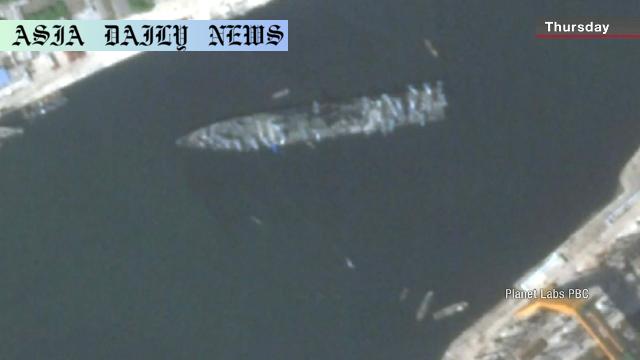Destroyer repairs progress as North Korea works to restore balance and functionality, with a focus on meeting leadership deadlines.

Introduction: North Korea’s Push for Naval Restoration
North Korea’s recent efforts in naval repair operations have drawn attention following the damaged destroyer’s successful relaunch. The vessel, which had partially submerged and tilted on its side at the Chongjin Shipyard, underwent rigorous restoration before being moored at a pier. This incident underscores North Korea’s focus on maintaining its naval fleet under tight deadlines imposed by the nation’s leadership.
Urgent Repairs at Chongjin Shipyard
According to reports in Rodong Sinmun, the ruling Workers’ Party newspaper, a dedicated repair team worked meticulously to restore the destroyer’s balance at the Chongjin Shipyard. The urgency to stabilize the damaged vessel stemmed from the ship’s critical condition after a failed launch attempt last month.
Satellite imagery from Planet Labs, taken on Thursday afternoon, confirmed the destroyer’s recovery progress. The vessel, now moored and floating steadily at Chongjin’s port, is evidence of swift and coordinated engineering efforts. The commitment to repair and restore such a major vessel highlights North Korea’s determination to strengthen its maritime defense capabilities.
Planned Restoration at Rajin Dockyard
The next phase of the repair operation will move to the Rajin Dockyard, also located in North Korea’s northeast. This dockyard is expected to play a pivotal role in not only completing technical repairs but also ensuring the destroyer’s long-term operational capacity. Current projections suggest that the restoration will take an additional 7 to 10 days—a timeline enforced by Kim Jong Un himself to align with the ruling party’s central committee plenary meeting scheduled for late June.
This tight timeframe reflects North Korea’s political and symbolic emphasis on the destroyer’s timely restoration. The vessel appears to signify both military resolve and technological prowess—a strategic message aimed at both domestic audiences and foreign observers.
Implications for Regional Security
The repair and restoration of the destroyer carry significant implications for regional security. North Korea’s naval capabilities and strategic priorities often serve as indicators of its broader military objectives. Analysts suggest that the vessel’s expedited repair could be motivated by the need to showcase power at an important juncture, particularly in the context of ongoing tensions on the Korean Peninsula.
Additionally, the transparency demonstrated in publicly sharing updates through state media could signal a calculated strategy to project confidence and competence. Whether this move is geared towards deterring adversaries or bolstering domestic morale, it undoubtedly adds another facet to the discourse surrounding North Korea’s military strategies.
Conclusion: A Symbol of Determination
North Korea’s rapid repair of its damaged destroyer is a testament to the nation’s resourcefulness and focus under tight deadlines. The operation showcases not only engineering efficiency but also the strategic alignment of military priorities with political agendas.
While the situation remains closely watched internationally, the repair team’s ability to stabilize the vessel marks a tangible achievement for the country’s naval forces. As North Korea continues repairs at the Rajin Dockyard, it remains to be seen how this development will influence both regional dynamics and domestic perceptions of the ruling government’s efficacy.
Commentary
A Bold Restoration Effort in the Midst of Challenges
The recent repairs of North Korea’s damaged destroyer bring an interesting showcase of determination, resilience, and technical prowess. While the nation often prioritizes opacity when it comes to military operations, the transparency shown in this case—through reports in the state-controlled Rodong Sinmun newspaper—is noteworthy. It reveals the symbolic value that the ruling Workers’ Party has ascribed to this restoration effort. For the regime, this vessel embodies more than military might; it encapsulates the ideologies of perseverance and technological self-reliance.
A Race Against Time and Symbolism
What stands out the most is the stringent timeline enforced by Kim Jong Un. With the ruling party’s central committee plenary meeting looming, the destroyer’s restoration appears to convey a broader political narrative. This deadline-driven approach reflects not only military priorities but also the projection of governance efficiency. However, such urgency raises questions about whether all necessary reparations can be made effectively in such a short phase.
Regional Repercussions: A Show of Strength
The destroyer repairs amid heightened regional tensions certainly carry a message of strength. North Korea’s naval ambitions, often juxtaposed with its missile development programs, provide insights into the nation’s broader defense strategy. This incident, though initially marked by failure, is transforming into an opportunity for the regime to project competency and unity in its military ranks. How regional actors perceive this restoration effort will undoubtedly have implications for the continued global dialogue on North Korea.
Overall, this event underscores the multifaceted nature of military operations and their interconnectedness with political strategy. It serves as a reminder that even seemingly isolated events within the confines of Chongjin Shipyard have broader narratives in play—ranging from domestic symbolism to international signaling.


